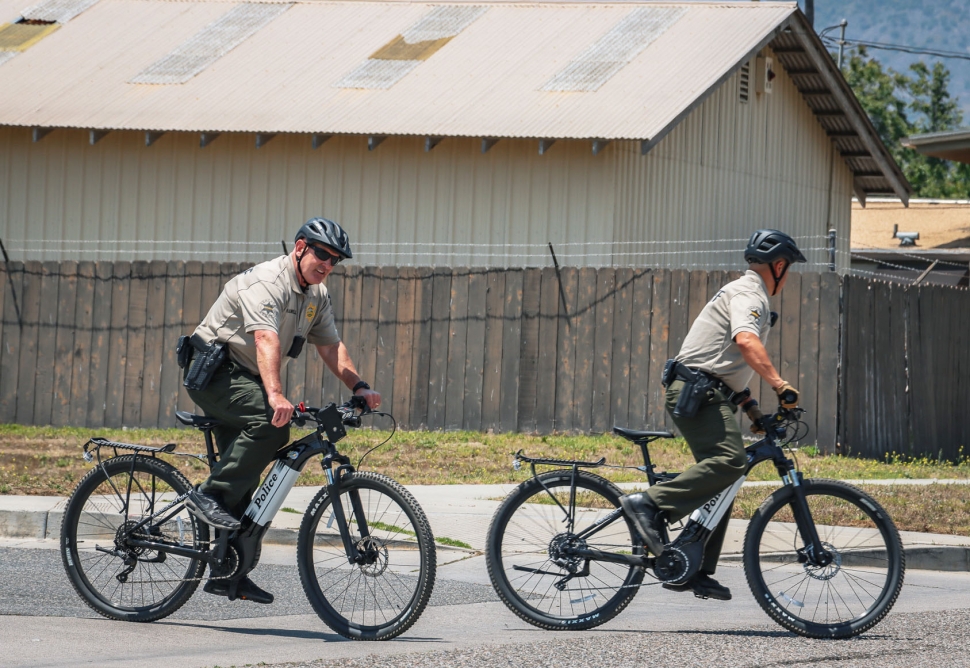|
E-Bike, Bicycle, and Scooter Education and Enforcement
 Pictured above are some of Fillmore’s Police in action, cruising on their E-bikes. Photo Credit Angel Esquivel. By Gazette Staff Writers — Friday, May 30th, 2025
The Ventura County Sheriff’s Office and the Cities of Fillmore, Camarillo, Thousand Oaks, Moorpark, and Ojai would like to address our youth and young adults’ growing use of E-bikes, bicycles, and electric scooters. These vehicles can be useful in reducing traffic and allowing young people a means of transportation other than motor vehicles to school and other activities. However, we have seen recent increases in collisions involving our youth on e-bikes, bicycles, and scooters. The increased speed provided by E-bikes and electric scooters requires increased care in their use. Traffic rules must be followed, and helmets must be worn at all times. Each type of the above-listed vehicle has specific rules for its use and operation. The Ventura County Sheriff’s Office has prepared two informational flyers outlining these rules. The Ventura County Sheriff’s Office and the above-listed contract cities are collaborating with local schools, Community Resource Units, and School Resource Deputies to provide in-person education on the rules, regulations, and safe use of E-bikes, bicycles, and electric scooters in our communities. The Ventura County Sheriff’s Office will focus on education, but will also consider enforcement of violations associated with electric motorcycles and their unlawful operation. The goal is to reduce traffic collisions, ensure safe operation, and prevent injuries, protecting the youth in our communities. Prepared by: Deputy Bradley Bordon • Class 1: A low speed pedal-assisted electric bicycle equipped with a motor which provides assistance only when the rider is pedaling and ceases to provide assistance when a speed of 20 mph is reached. • Class 2: A low speed throttle-assisted electric bicycle equipped with a motor used exclusively to propel the bicycle and NOT capable of providing assistance when a speed of 20 mph is reached. • Class 3: A low speed pedal-assisted electric bicycle equipped with a speedometer, and a motor which provides assistance only when the rider is pedaling and ceases to provide assistance when a speed of 28 mph is reached. The operator of a Class 3 electric bicycle: • Must be 16 years old or older. • Must wear a bicycle safety helmet. • Must not transport passengers. • May ride an electric bicycle in a bicycle lane if authorized by local authority or ordinance. All electric bicycle classes are exempt from the motor vehicle financial responsibility, DL, and license plate requirements (VC 24016). The vehicle code requires all bicyclist to follow the rules of the road. See the following link for more information. Electric Motorcycles *** These are defined by the California Vehicle Code A “motorized scooter” is any two-wheeled device that has handlebars, has either a floorboard that is designed to be stood upon when riding or a seat and footrests in place of the floorboard, and is powered by an electric motor. This device may also be designed to be powered by human propulsion. For purposes of this section, a motorcycle, as defined in Section 400, a motor-driven cycle, as defined in Section 405, or a motorized bicycle or moped, as defined in Section 406, is not a motorized scooter. VC 21235: (a) Operate a motorized scooter unless it is equipped with a brake that will enable the operator to make a braked wheel skid on dry, level, clean pavement. (b) Operate a motorized scooter on a highway with a speed limit in excess of 25 miles per hour unless the motorized scooter is operated within a Class II or Class IV bikeway, except that a local authority may, by ordinance or resolution, authorize the operation of a motorized scooter outside of a Class II or Class IV bikeway on a highway with a speed limit of up to 35 miles per hour. The 15 mile per hour maximum speed limit for the operation of a motorized scooter specified in Section 22411 applies to the operation of a motorized scooter on all highways, including bikeways, regardless of a higher speed limit applicable to the highway. (c) Operate a motorized scooter without wearing a properly fitted and fastened bicycle helmet that meets the standards described in Section 21212, if the operator is under 18 years of age. (d) Operate a motorized scooter without a valid driver’s license or instruction permit. (e) Operate a motorized scooter with any passengers in addition to the operator. (f) Operate a motorized scooter carrying any package, bundle, or article that prevents the operator from keeping at least one hand upon the handlebars. (g) Operate a motorized scooter upon a sidewalk, except as may be necessary to enter or leave adjacent property. (h) Operate a motorized scooter on the highway with the handlebars raised so that the operator must elevate his or her hands above the level of his or her shoulders in order to grasp the normal steering grip area. (i) Leave a motorized scooter lying on its side on any sidewalk or park a motorized scooter on a sidewalk in any other position, so that there is not an adequate path for pedestrian traffic. (j) Attach the motorized scooter or himself or herself while on the roadway, by any means, to any other |
